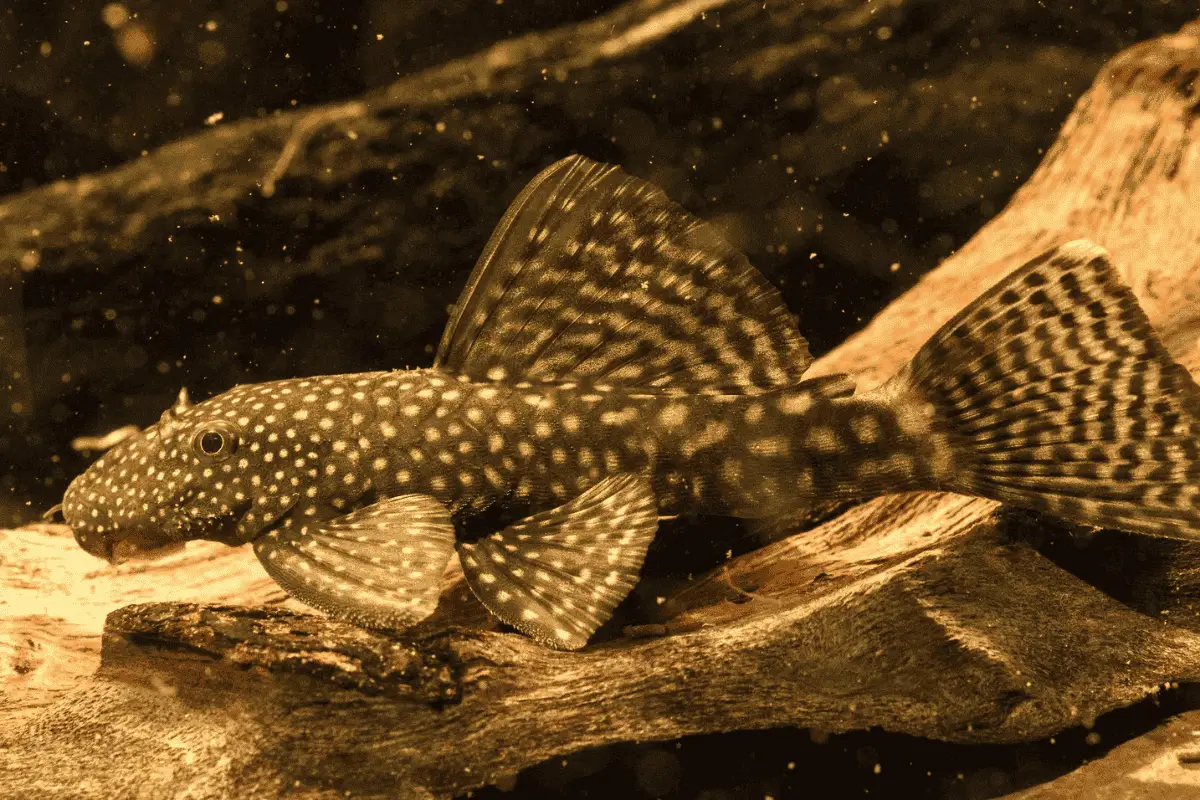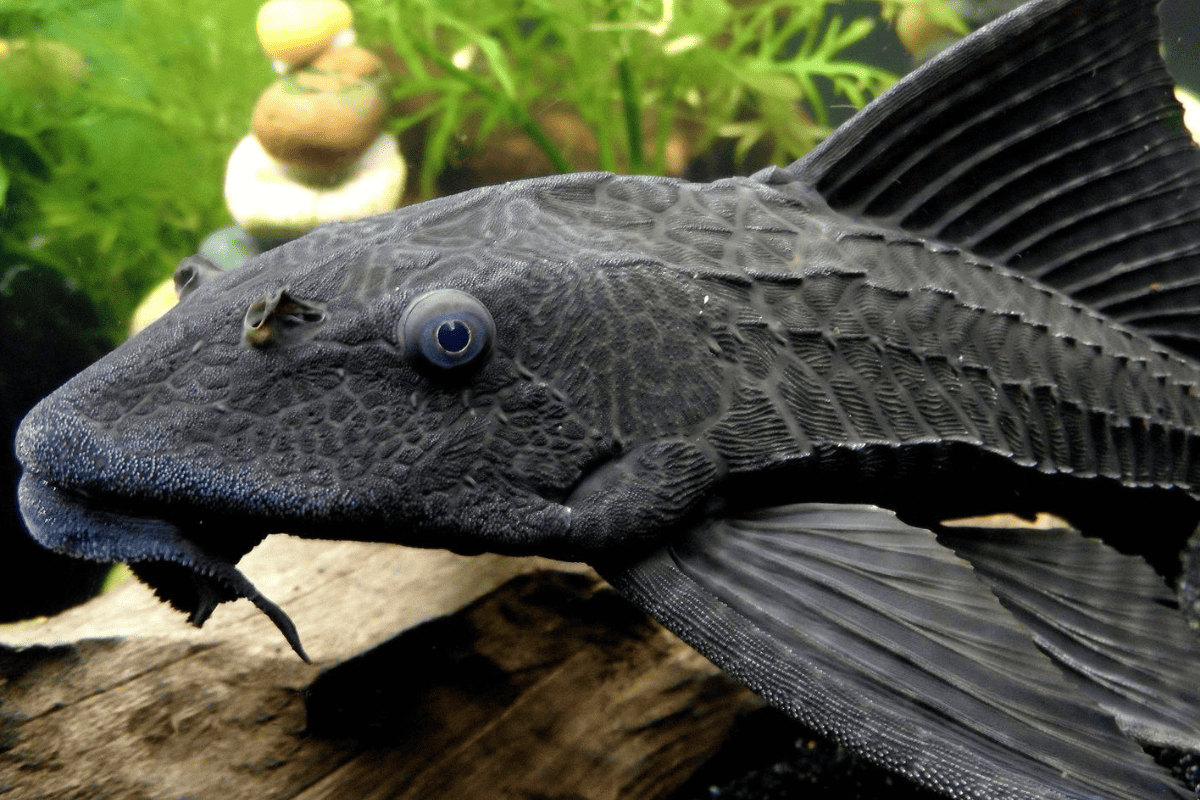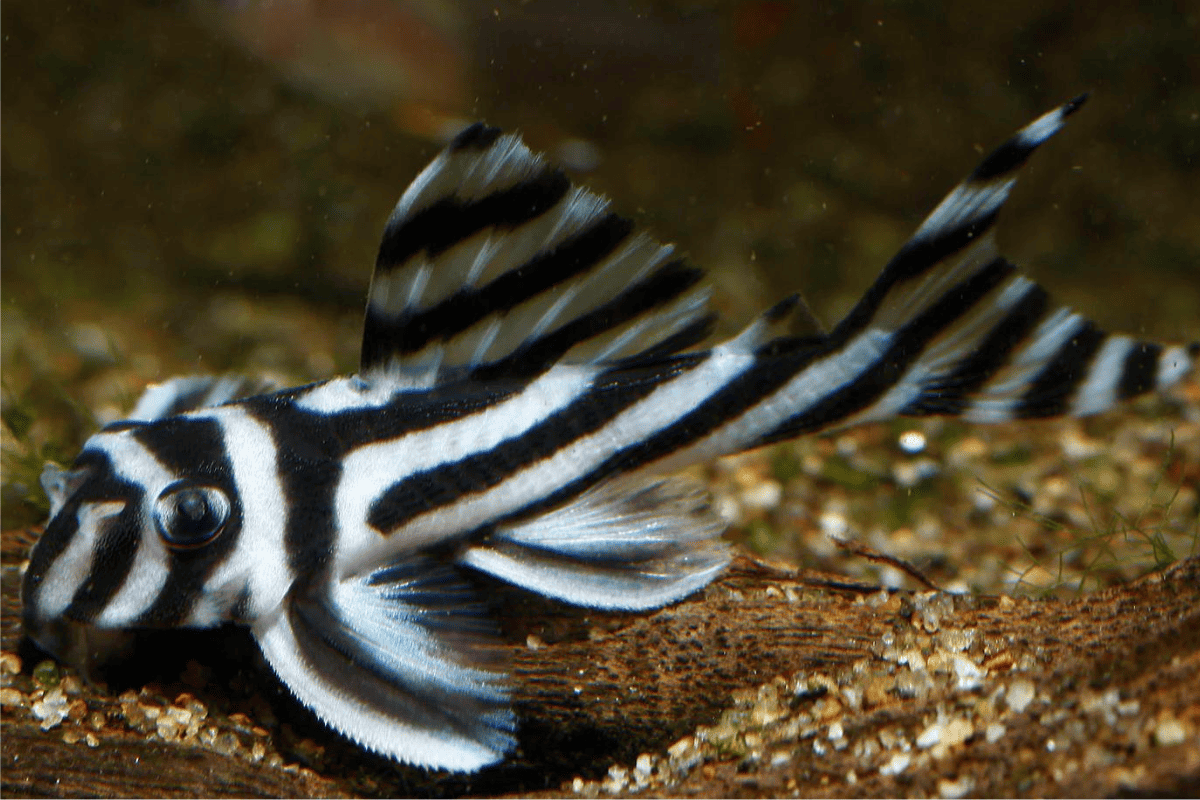If you have a Pleco fish or plan to get one and are curious about their feeding habits, you’ve landed on the right page.
How much should you feed these types of fish? How do you know if they are underfed? How often should you feed them? Can you accidentally overfeed them?
Here, I’ll discuss all these questions and more, so you leave with all the information you need. Let’s get started.
Also Read: How To Feed Plecos

How Much to Feed Plecos
Your Pleco’s appetite largely depends on the kind of food you offer. Here’s the lowdown:
| Food Type | Feeding Amount |
| Algae Wafers | 1-2 wafers daily for medium-sized Pleco (4-6 inches) |
| Sinking Pellets | 2-3 pellets daily for standard-sized Pleco |
| Fresh Vegetables | 1-2 thin slices of cucumber or zucchini every other day |
| Driftwood | Always present in the tank for digestion for certain Plecos |
| Bloodworms | Small pinch (5-6 worms) for average-sized Pleco; feed once a week or less |
1. Algae Wafers
Algae is a Pleco’s best friend. These wafers are specially formulated to meet their nutritional requirements.
- Quantity Tip: For a medium-sized Pleco (4-6 inches), 1-2 wafers daily should do the trick.
- Frequency Insight: Feed them every day, and occasionally intersperse with different food items for variety.
- Overfeeding Alert: Keep an eye out and clear away any uneaten wafers after a few hours to keep the tank tidy.
My recommendation: Invert Aquatics Mini Algae Discs (link to Amazon).

2. Sinking Pellets
These pellets are another nutrient-rich option for Plecos. They’re made to settle at the tank’s bottom where Plecos usually dine.
- Quantity Tip: A daily dose of 2-3 pellets is good for a standard-sized Pleco, ensuring they get their essential nutrients.
- Frequency Insight: Daily servings are great, but coupling this with other food items brings balance to their diet.
- Variety Suggestion: Change things up now and then with wafers or fresh veggies to spice up your Pleco’s mealtime.
My recommendation: Hikari Sinking Carnivore Pellets (link to Amazon).
3. Fresh Vegetables
Plecos enjoy a veggie treat now and then, which provides them with essential fibers.
- Quantity Tip: A thin slice or two of cucumber or zucchini every other day can be a delightful addition to their regular diet.
- Frequency Insight: Introduce fresh vegetables 2-3 times a week, ensuring they get natural fibers.
- Preparation Note: Always wash vegetables thoroughly and anchor them to the tank bottom for easier access.

4. Bloodworms
A treat for Plecos, bloodworms offer protein but should be provided in moderation.
- Quantity Tip: For an average-sized Pleco, a small pinch of bloodworms, equivalent to about 5-6 worms, is enough for a treat.
- Frequency Insight: Consider offering bloodworms once a week or less, ensuring they aren’t the primary food source.
- Nutrient Note: Remember, bloodworms are protein-rich but lack the essential nutrients present in pellets and wafers.
My recommendation: San Francisco Bay Brand Freeze Dried Bloodworms (link to Amazon).
5. Driftwood
Not just a tank decoration, driftwood is essential for some Pleco species for digestive reasons.
- Digestive Aid: Plecos often gnaw on driftwood, aiding in digestion and providing necessary fibers.
- Frequency Insight: While they won’t ‘eat’ it like regular food, ensure driftwood is always present in the tank for those species that need it.
- Selection Advice: Choose a piece of driftwood that’s smooth and sizable enough for your Pleco to interact with comfortably.
My recommendation: Dr. Moss Malaysian Driftwood (link to Amazon).

What Do Juvenile and Baby Plecos Eat?
Juvenile and baby Plecos have specific dietary requirements to ensure their healthy growth and development.
They need a mix of high-quality foods, rich in protein and vital nutrients, tailored to their smaller size.
- High-Quality Pellets: For juvenile Plecos, consider specially formulated sinking pellets. They are nutrient-rich, ensuring that your young Plecos receive the essential vitamins and minerals they need for growth.
- Crushed Algae Wafers: Algae is vital for Plecos at any stage. For babies, it’s recommended to crush the wafers into smaller, manageable pieces, making it easier for them to eat.
- Fresh Vegetables: Young Plecos benefit from thinly sliced vegetables like zucchini or cucumber. Offer these 2-3 times a week, ensuring they’re soft enough for their small mouths.
- Small Bloodworms: Protein is crucial at this growth stage. Introduce a few bloodworms once a week, ensuring they are appropriately sized for the young Plecos.
- Frequent Feeding: Baby and juvenile Plecos have a faster metabolism. Feed them 2-3 times a day in smaller quantities, ensuring they get consistent nourishment without overfeeding.
What Is the Best Feeding Approach for Different Types of Plecos?
Plecos, with their vast variety, have distinct dietary requirements based on their type.
Understanding these requirements is essential to ensure they thrive and display their unique behaviors and appearances.
1. Omnivorous Plecos
Species like the Common Pleco and Clown Pleco fall into this category, requiring a balanced diet of both plant and animal-based foods.
- Balanced Diet: Omnivorous Plecos thrive on a mix of algae wafers, fresh vegetables, and occasional protein like bloodworms.
- Feeding Quantity: For an average-sized Omnivorous Pleco, 1-2 wafers combined with other food sources daily is sufficient.
- Frequency Insight: Feed them daily, but ensure variety throughout the week to mimic their natural diet.
- Diverse Example: The Clown Pleco, while loving wood, also enjoys a mix of proteins and greens.

2. Carnivorous Plecos
Species like the Panaque and Zebra Pleco are more protein-focused, showing a preference for meaty foods.
- Meaty Foods: Carnivorous Plecos relish foods like bloodworms, brine shrimp, and sinking carnivore pellets.
- Feeding Quantity: A few bloodworms combined with 1-2 sinking carnivore pellets daily suit their dietary needs.
- Frequency Insight: Feed them once daily, but ensure a protein-rich diet with minimal plant matter.
- Notable Species: The Zebra Pleco, with its striking appearance, requires a consistent protein source for vibrant colors.

3. Herbivorous Plecos
Species like the Rubber Lip Pleco and Bristlenose Pleco are primarily herbivores, thriving on a plant-based diet.
- Plant-Based Foods: Herbivorous Plecos need a steady intake of algae wafers, fresh veggies, and occasionally gnaw on driftwood.
- Feeding Quantity: 2-3 algae wafers a day, supplemented with fresh slices of zucchini or cucumber, keep them content.
- Frequency Insight: Daily feeding with a focus on green foods ensures their health and vitality.
- Distinct Diet: The Bristlenose Pleco, for instance, enjoys algae growth in the tank and might need less supplemental feeding when enough is present.
Also Read: What Do Plecos Eat?

How Often Should I Feed Plecos?
Adult Plecos generally benefit from a daily feeding routine, ensuring they receive a varied and balanced diet.
However, specifics can differ based on the food type, the Pleco’s age, and other unique considerations.
- Age Factor: Juvenile Plecos are growing rapidly and need more energy, hence feeding them 2-3 times daily with controlled portions is recommended for optimal growth.
- Food Type: When providing fresh veggies like zucchini or cucumber, they can stay in the tank for a bit; you might feed other foods every alternate day to balance it out.
- Active Plecos: Species that are inherently more active or those in slightly warmer tanks may have increased metabolism, requiring a touch more frequent nourishment.
- Dietary Needs: Carnivorous Plecos have a distinct requirement for proteins; consistently offering foods like bloodworms daily can meet this need effectively.
- Observation Tip: Continuously monitor your Pleco’s behavior; if they seem to be always on the hunt, it might indicate a need for slightly increased feeding frequency.
How Do I Know If My Pleco Is Eating Enough?
Recognizing if your Pleco is well-nourished involves a mix of behavioral observation and physical assessments.
These fish will exhibit distinct signs indicating their nutritional status and overall well-being.
- Physical Appearance: A Pleco in good health should exhibit a robust and filled-out body; any visible signs of hollowness or bones protruding can be concerning.
- Activity Level: A Pleco that’s feeding adequately will display a balance in activity, being curious and active, but not appearing desperately scavenging.
- Waste Production: If your Pleco is digesting well and eating adequately, you’ll notice consistent waste production, indicating a functioning digestive system.
- Tank Cleanliness: Observing the algae levels in your tank is key; consistently low algae and quickly disappearing veggies hint at a well-fed Pleco.

What Does a Starving Pleco Look Like?
A starving Pleco will exhibit clear physical and behavioral signs of malnutrition. It’s crucial to recognize these symptoms early to ensure your fish’s well-being.
- Sunken Belly: One of the most evident signs in starving Plecos is a noticeably sunken or hollow belly, indicating insufficient nourishment.
- Protruding Bones: When looking from above or the side, you may observe the Pleco’s skeletal structure more prominently, especially around the head and spine.
- Lethargic Movement: Starving Plecos often display reduced energy levels, moving sluggishly around the tank or staying static for prolonged periods.
- Loss of Vibrancy: Their color might appear faded or less vibrant, showing a general lack of health and vitality, contrasting their usual lively appearance.
What Are The Risks of Overfeeding Plecos?
Feeding Plecos too much, even with the best of intentions, can cause numerous health and tank problems.
It’s just as harmful as not feeding them enough, negatively affecting the fish and the aquarium’s environment.
- Digestive Complications: Overfeeding can cause Plecos to experience bloating or constipation, which harms their digestion and overall health.
- Declining Water Quality: Food that isn’t eaten breaks down, releasing ammonia and nitrites. These substances can quickly reduce water quality, which isn’t good for Plecos.
- Algae Overgrowth: Overfeeding leads to excess nutrients that can spur unwanted algae growth, making the tank less hospitable for Plecos.
- Obesity Risks: Like other animals, Plecos can gain too much weight, which stresses their internal organs and can shorten their lifespan.
- Behavioral Shifts: Plecos that eat too much might become sluggish and engage less in their natural scavenging activities, reducing their overall quality of life.

How Long Can Plecos Go Without Eating?
While Plecos, like many other fish, can go without food for a brief period, usually about a week, it’s not ideal. Being without food can stress them out and impact their health.
- Natural Foragers: Naturally, Plecos scavenge and might find some algae and debris in the tank when food is scarce.
- Increased Stress: Going too long without food can significantly stress Plecos, which weakens their immune system.
- Health Decline: Even if Plecos can last a week without eating, their health could start to suffer after just a few days.
- Plan Ahead: If you’re going to be away, think about using an automatic feeder or having someone check on your Plecos to keep them well-fed.
Should Plecos Eat More When They’re Breeding?
Yes, when breeding, Plecos need extra food to meet their higher energy needs. Providing more sustenance helps ensure they stay healthy and can reproduce successfully.
- Higher Energy Needs: The breeding process is energy-intensive, so Plecos will benefit from more food during this time.
- Quality is Key: It’s not just about more food; the quality matters. Foods rich in protein aid in egg production and boost vitality.
- Avoid Overfeeding: Even when providing more food, be careful not to give too much. Overfeeding can harm water quality and stress other fish in the tank.
- Add Some Veggies: Fresh veggies, like zucchini, provide essential nutrients that support the health of breeding Plecos and boost reproductive success.

Conclusions
For those skimming, here’s a quick recap:
- Plecos thrive on algae wafers and sinking pellets, which should be given in the suggested daily amounts to ensure a varied diet.
- Fresh veggies like cucumbers and zucchinis are great dietary additions, given 2-3 times a week, to increase their natural fiber intake.
- Driftwood is more than just a decoration; for some Pleco species, it helps with digestion and enhances their well-being.
- While Plecos enjoy bloodworms, offer them sparingly due to their high protein content and missing essential nutrients.
- Regularly observe your Pleco’s appearance, behavior, waste, and the tank’s cleanliness to make sure they’re eating right and staying healthy.
